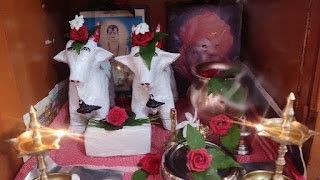Significance of Mannettina Amavasya-Obeisance to Bullocks
It just took me back to my childhood days in MTS Colony Hubballi, Karnataka State India. I would also engage in playing with potter’s clay in my neighbor Shri Gopinathacharya’s house and make small toys and stuff later to be thrown out by my family. Maybe my first-hand experience of clay work was much encouraged by Mama and Mami (that’s the loving liberty of addressing elders then). Every occasion of celebration had a significance that would be guiding the energy of living. “What an artful life was led and enjoyed by our ancestors?”—I question often myself. Thanks to social media like Whatsapp groups and Facebook for rekindling hidden golden memories.
Human beings had to live amongst other animal species by respecting and let live the kind of life skills adopted by our ancestors. One such celebration is “Mannettinna Amavasya” day. Maneettina Amavasya is celebrated as per the Hindu Lunar Almanac Jyestha month (June-July) Shukla Paksha on the day of New Moon Day. The word “Mannu” means soil and is colloquially also known as ‘mud’ and ‘Yethu’ or ‘Yethulu’ or ‘Yedulu’ meaning a pair of bullocks. This festival is celebrated in full vigour in North Karnataka, Andhra Pradesh, Telangana, and in Some parts of Maharashtra state also.
During summer it is mostly wedding seasons and ploughing of the farming land before the arrival of the monsoon. Right from tilling the land to seed sowing to harvesting and transportation, farmers depend upon bullocks. The main livestock of the farmer is a pair of bullocks which is more precious than his own children. The bullocks are given a good bath; horns are painted and bedecked with flower garlands, and brass or silvery bells are decorated around the neck. They are then fed different types of food grains and pulses. Usually, a dish known as Usali or usuli is prepared out of pulses is fed, some even feed dosas- Indian famous pancakes.
Apart from this a pair of clay bullocks are also made or molded or purchased from the potter who sells A good number of clay bullocks idols. A pair of clay bullocks is placed in the pooja room and worshipped by offering Haldi-Kumkum and flowers. This evening is a playful task for children who get to do the immersion the same in the village pond/ lake.
The whole celebration signifies the significance of the dependency on cattle for our existence-be it a cow, bull, or ox. They are the main source of milk, for ploughing, and for transportation. It is repaying respect to the bullocks and the soil on which a farmer depends the most. And we depend upon the farmer for the food grain production. So it is a circular chain of interdependence.
A similar kind of celebration is also seen practiced in different states of India and also among tribes.















Comments
Regards
Sphoorthi